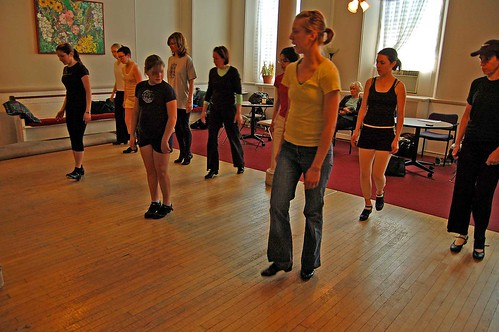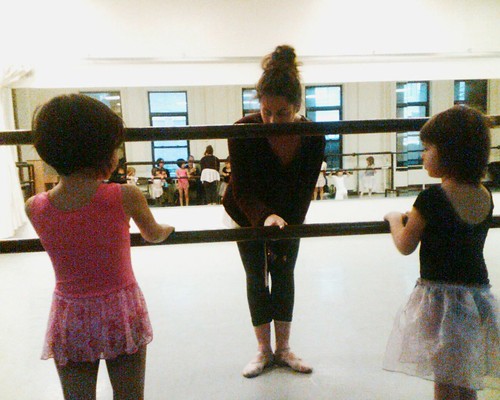A question was posed during a recent DanceStudioOwner teleseminar – When and how should piqué turns be taught? Given my recent Piqué Turn How-To, I thought I would expand into my process for teaching this turn. I am offering my own thoughts and method which are based on my experiences as a student and teacher and not on a particular ballet syllabus. In fact, much of this approach could be applied to jazz or other dance forms as well.
When and How
As this was the nature of the question, I believe, I am going to stick to explaining my methods for teaching piqué tour en dedans (or pirouette piquée).
My timeline for introducing and teaching both the elements of this movement and the movement itself:
Preschool-8yrs: Students add a passé in their ballet walk practice across the floor. With young ones, I sometimes refer to these as “flamingo walks.” At the preschool level, students practice these in parallel (stretching the knee and pointing the toe on each step). At age 6 students can practice these turned out and later I have them practice pas marché across the floor (with a small piqué onto demi-pointe but without plié on the descent). At this stage I encourage stepping onto a straight leg for pas marché, however I’ve found that not all students do this consistently and need lots of reminding as this requires a lot of control to do well.
6-8yrs old: Students enrolled in a Pre-Ballet class/Ballet class practice retiré facing the barre, then with one hand on the barre (on flat and later demi-pointe), then during centre practice (usually flat only). They also be practice pas marché (as mentioned above).
8-9yrs old: At around age 8 (maybe 7 for experienced dancers) I begin teaching piqué retiré facing the barre. I have students move sideways one at a time down the length of the barre so that they have the support of the barre while trying to find the right reach of the toe that will allow them to step onto a straight leg without lifting the working hip. Later, partially because piqué turns include a swivel of the hip which squares the hips toward the direction of travel (see my explanation of this in a former post), I have the students move their piqué retiré forward with one hand along the barre. In this exercise the hand that is on the barre is the same as the supporting leg, opposite the gesture leg. This allows students to practice the closing of the arm to 1st position (5th en avant – Cecchetti). Be sure that students are keeping the barre arm in front of their body as they move forward.
9-10yrs old: When most students in the class show understanding, control, and good placement while executing their piqué at the barre, I then move this practice to the centre. I encourage the students to try and find their balance on the leg each time, occasionally “surprising” them with a FREEZE! and challenging them to maintain this balance until I say GO! It is important during this stage to remind them to draw the foot down the leg as they descend and to utilize the same working-leg preparation as they would in the turn. (Note: Around this time, I also begin teaching piqué arabesque along the barre and across the floor.)
10 and up: When most students demonstrate good control, placement, and balance in piqué retiré without turning, I then add the turn. If the students have been solid in their practice and progression up to this point, generally this transition is relatively smooth. However, adding a turn is a big change and can “throw off” or “psych out” some students. In this case, be encouraging and remind them that all of the same principles apply, going back to the more simplified version if and whenever necessary.
When piqué tour en dedans has been mastered, I will begin to teach other versions of this turn including piqué tour en attitude, en dehors, and en arabesque (usually in that order).
Progression for older beginners

When working with students brand new to piqué turns (or those who perhaps need some re-training in this area), no matter their age, I begin their study just as I would my pre-ballet students: facing the barre, working on a proper retiré. Older students my be able to progress more quickly, but I follow the same progression, always looking for understanding and application of concepts from the majority of the class before moving on.
Perhaps in contradiction to myself, I want to add that there is something to be said for just giving something a whirl. What do I mean by that? It is OK to occasionally break from this seemingly strict progression and let students (at whatever age or skill level) try things once in a while, particularly in turning. This is because sometimes students’ instinct in turning can take over and actually be a useful tool in teaching or correcting the version without the turn! Also, taking too rigid a stance with your structure may bore students. It is important to find a balance and allow students to see how care and diligence in “the basics” improves and informs their execution of more advanced steps.
A Note on Using Imagery

I’ve found imagery to be an extremely useful tool for aiding understanding and performance of the technical aspects of dance. Some of the images I present to students regarding piqué turns can be found in my last post, but there are certainly others.
I hope you found this helpful. I welcome your thoughts on this progression of study and any other ideas you have on teaching piqué turn. Posting in the comments here opens discussion and allows others to see varying methods of instruction. My way, is certainly not the only way!
Nichelle Suzanne is a writer specializing in dance and online content. She is also a dance instructor with over 20 years experience teaching in dance studios, community programs, and colleges. She began Dance Advantage in 2008, equipped with a passion for movement education and an intuitive sense that a blog could bring dancers together. As a Houston-based dance writer, Nichelle covers dance performance for Dance Source Houston, Arts+Culture Texas, and other publications. She is a leader in social media within the dance community and has presented on blogging for dance organizations, including Dance/USA. Nichelle provides web consulting and writing services for dancers, dance schools and studios, and those beyond the dance world. Read Nichelle’s posts.


